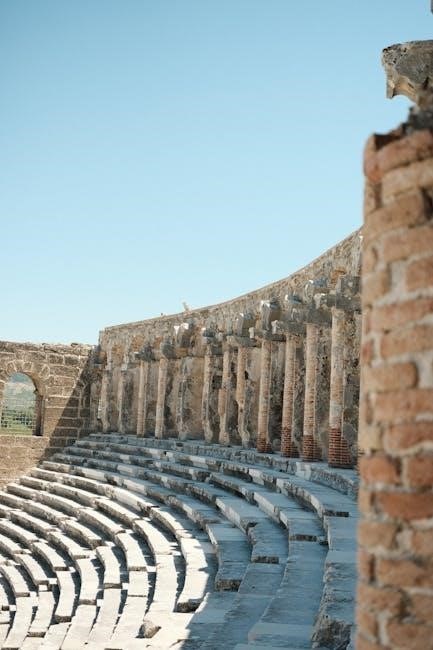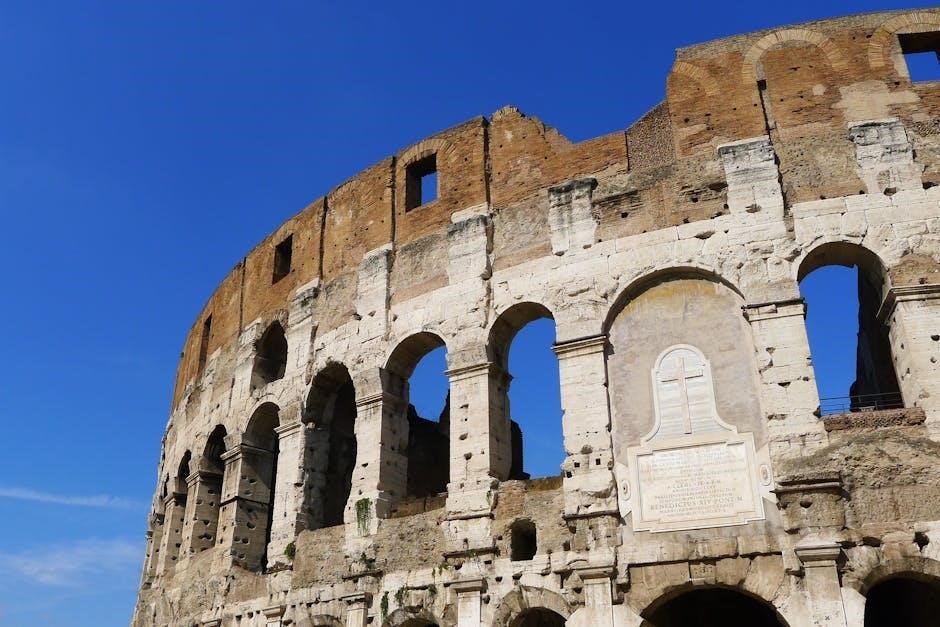
The Roman Empire’s decline and fall remains a pivotal historical event, shaping modern understanding of political and cultural transformations. Edward Gibbon’s seminal work provides a comprehensive account, exploring the empire’s rise, peak, and eventual collapse. This period continues to fascinate scholars and historians, offering insights into the complexities of power, governance, and societal evolution.
1.1 Overview of the Roman Empire’s Historical Significance
The Roman Empire stands as one of history’s most influential civilizations, shaping law, governance, and culture across vast territories. Its legacy endures in modern legal systems, architecture, and political structures. The empire’s rise and dominance exemplify the potential of centralized authority and military prowess. However, its decline offers profound lessons on the fragility of power and the complexities of maintaining vast territories. Studying the Roman Empire provides insights into the dynamics of human societies, making it a cornerstone of historical inquiry and a timeless subject of scholarly exploration and public fascination.
1.2 Importance of Studying the Decline and Fall
Studying the decline and fall of the Roman Empire offers invaluable lessons for understanding the rise and fall of civilizations. It provides insights into the consequences of military overextension, economic instability, and political corruption. By examining these factors, historians and scholars can draw parallels with modern societies, highlighting the importance of sustainable governance and cultural resilience. Additionally, Gibbon’s work remains a cornerstone of historical scholarship, demonstrating the enduring relevance of classical studies in contemporary discourse. The study of Rome’s fall serves as a cautionary tale, emphasizing the need for vigilant leadership and adaptive governance in an ever-changing world.
Key Causes of the Decline and Fall
The Roman Empire’s decline stemmed from military overextension, economic troubles, and political instability. These factors, combined with external pressures, ultimately led to its collapse and transformation.
2.1 Military Overextension and Its Consequences
Military overextension was a critical factor in the Roman Empire’s decline. The empire’s vast territories required extensive border defense, leading to constant warfare and significant resource depletion. Maintaining large armies strained the economy, while frequent campaigns diverted focus from internal stability. Over time, the military became less effective due to over-reliance on mercenaries and internal conflicts. This overextension weakened the empire’s ability to respond to external threats and internal crises, contributing to its gradual decline and eventual fall. The burden of military expenses further exacerbated economic troubles, creating a cycle of instability and vulnerability.
2.2 Economic Troubles and Inflation
Economic troubles and inflation significantly contributed to the Roman Empire’s decline. The empire faced severe financial strain due to costly wars, excessive spending, and a decline in trade. The debasement of currency, particularly the reduction of silver content in coins, led to rampant inflation, eroding purchasing power and destabilizing the economy. Heavy taxation further burdened citizens, reducing productivity and leading to widespread poverty. These economic challenges weakened the empire’s infrastructure and social structures, making it increasingly difficult to sustain its vast territories and military endeavors. Economic instability became a persistent issue, undermining the empire’s long-term viability and contributing to its eventual collapse.
2.3 Political Instability and Corruption
Political instability and corruption plagued the Roman Empire, weakening its governance and legitimacy. Constant power struggles, assassinations, and coups created an environment of chaos, with emperors frequently being overthrown. The Praetorian Guard’s influence in imperial succession further destabilized the political system. Corruption permeated all levels of administration, with officials embezzling funds and abusing power. This mismanagement eroded public trust and undermined the empire’s ability to respond effectively to external and internal challenges. The lack of strong, consistent leadership exacerbated these issues, contributing to the empire’s gradual decline and eventual fragmentation.

Social and Cultural Factors
The decline of traditional Roman values and the rise of new cultural influences contributed to significant social changes, impacting the empire’s stability and continuity.
3.1 Decline of Traditional Roman Values
The decline of traditional Roman values played a significant role in the empire’s downfall. As the empire expanded, the influx of diverse cultures and religions eroded the once-strong Roman identity. The shift from a disciplined republic to a decadent empire led to moral decay and a disconnection from the values that once unified Rome. The influence of conquered peoples and the rise of new religious beliefs, such as Christianity, further diluted traditional Roman customs. This cultural transformation weakened social cohesion and contributed to the empire’s internal instability, as noted by historians like Edward Gibbon in his seminal work.
3.2 Impact of Public Health Crises
Public health crises significantly weakened the Roman Empire, exacerbating its decline. Major pandemics, such as the Antonine Plague (165–180 CE) and the Plague of Justinian (541–542 CE), devastated populations, leading to labor shortages and economic instability. These outbreaks disrupted military recruitment, agricultural production, and urban life. The empire’s extensive trade networks, while economically beneficial, also facilitated the spread of diseases. The loss of manpower and societal instability from these health crises undermined the empire’s ability to maintain its vast territories and respond to external threats, contributing to its eventual fall, as documented in historical accounts and scholarly analyses.
External Pressures and Barbarian Invasions
The Roman Empire faced relentless external pressures, with barbarian tribes launching frequent invasions. These attacks destabilized borders, drained resources, and weakened imperial authority, contributing to its decline.
4.1 Role of Neighboring States and Tribes
Neighboring states and tribes played a significant role in the decline of the Roman Empire. Their continuous raids and invasions strained Roman military resources, while internal instability made the empire vulnerable. The pressure from these external forces weakened Rome’s ability to maintain control over its vast territories, leading to territorial losses and economic strain. Additionally, the integration of barbarian groups into the empire often led to internal conflicts, further destabilizing the political and social fabric of the Roman state, contributing to its eventual fall.
4.2 The Sack of Rome and Its Aftermath
The sack of Rome, particularly by Alaric and the Visigoths in 410 CE, sent shockwaves throughout the empire. This event symbolized the vulnerability of the once-invincible capital, eroding confidence in Roman authority. The aftermath saw increased instability, as political and military leaders struggled to regain control. The psychological impact was profound, marking a turning point in the empire’s decline. The sack also accelerated the shift of power from Rome to Constantinople, while the western empire faced further fragmentation and eventual collapse, highlighting the irreversible decline of Roman dominance.

The Role of Religion
Religion played a pivotal role in the Roman Empire’s transformation, as the rise of Christianity challenged traditional pagan practices, reshaping societal values and political structures, contributing to its decline.
5.1 Rise of Christianity and Its Influence
The rise of Christianity fundamentally transformed the Roman Empire, shifting cultural and political landscapes. As the faith spread, it challenged traditional Roman values and institutions, creating social and religious tensions. The new religion’s emphasis on equality and morality appealed to the masses, eroding the empire’s pagan foundations. Over time, Christianity became intertwined with imperial authority, influencing laws and governance. This religious evolution played a significant role in the empire’s decline, as it weakened the cohesion of the state and its ability to adapt to external pressures. Gibbon’s work highlights this transformative period as critical to the empire’s eventual fall.
5.2 Conflict Between Pagan and Christian Populations
The rise of Christianity sparked significant tensions between pagan and Christian populations within the Roman Empire. This religious divide weakened social cohesion and political stability. Pagans viewed Christians as a threat to traditional Roman values, while Christians saw themselves as morally superior, refusing to participate in state-sponsored religious practices. Persecutions and conflicts escalated, further polarizing the empire. This internal strife distracted from external threats and contributed to the empire’s decline. The eventual dominance of Christianity shifted the empire’s cultural and political landscape, marking a turning point in its history. These religious conflicts remain a key focus in Gibbon’s analysis of the empire’s fall.
The Legacy of Edward Gibbon’s Work
Edward Gibbon’s “The History of the Decline and Fall of the Roman Empire” remains a cornerstone of historical scholarship, offering a detailed and insightful exploration of the empire’s transformation. His work has endured as a foundational text, shaping modern understanding of ancient history and sparking ongoing scholarly debates about the causes of the empire’s decline. Gibbon’s meticulous research and narrative style continue to influence historians and researchers, ensuring his legacy as a pioneering figure in the study of the Roman Empire’s fall.
6.1 Overview of “The History of the Decline and Fall of the Roman Empire”
Edward Gibbon’s “The History of the Decline and Fall of the Roman Empire” is a six-volume masterpiece chronicling the Roman Empire’s transformation from its peak to its dissolution. Written between 1776 and 1789, the work spans over 1,200 years of history, blending meticulous research with engaging narrative. Gibbon’s account explores the empire’s military, political, and social dynamics, offering a comprehensive analysis of its rise and fall. Available as a PDF or eBook, this seminal work remains a cornerstone of historical study, providing invaluable insights into the complexities of ancient Rome’s legacy and its enduring impact on modern civilization.
6.2 Gibbon’s Key Arguments and Contributions
Edward Gibbon’s “The History of the Decline and Fall of the Roman Empire” presents a meticulous analysis of the empire’s collapse, attributing it to military overextension, economic decay, and political corruption. Gibbon argued that internal decay, rather than external pressures, was the primary cause of the empire’s fall. He also emphasized the transformative impact of Christianity, which shifted societal values and weakened traditional Roman institutions. Gibbon’s work remains influential, offering a balanced and detailed account that has shaped historical scholarship, despite modern critiques of his perspectives on religion and certain historical events.
The Roman Empire’s decline and fall highlights the fragility of power. Gibbon’s work remains a cornerstone of historical analysis, offering timeless lessons on internal decay and external pressures.

7.1 Summary of the Roman Empire’s Decline
The decline of the Roman Empire was a complex, multifaceted process marked by internal decay and external pressures. Military overextension drained resources, while economic troubles and inflation eroded stability. Political corruption and instability further weakened the empire’s structure. External threats from barbarian invasions and rival powers exacerbated these challenges. The sack of Rome in 410 CE symbolized the empire’s vulnerability. Societal shifts, including the decline of traditional values and public health crises, contributed to its unraveling. Gibbon’s work underscores the interplay of these factors, illustrating how the empire’s once-mighty structure crumbled under cumulative strain.
7.2 Lessons from the Fall of the Roman Empire
The fall of the Roman Empire offers timeless lessons about governance, resilience, and societal cohesion. It highlights the dangers of unchecked power, corruption, and mismanagement. The empire’s collapse underscores the importance of sustainable economic practices, military prudence, and cultural adaptability. Gibbon’s analysis reveals how internal decay and external pressures can undermine even the mightiest civilizations. These insights remain relevant today, serving as a cautionary tale for modern societies grappling with similar challenges, such as political polarization, economic inequality, and external threats.

References and Further Reading
Edward Gibbon’s The History of the Decline and Fall of the Roman Empire is a seminal work. For further reading, explore PDF resources and scholarly analyses.
8.1 Recommended PDF Resources and Historical Accounts
For in-depth exploration, Edward Gibbon’s The History of the Decline and Fall of the Roman Empire is indispensable. The Portable Library of Liberty offers a free PDF version of this seminal work. Additionally, Volume 5 of Gibbon’s account, available on platforms like Project Gutenberg, provides detailed insights into the empire’s final centuries. These resources offer a comprehensive narrative, supported by historical evidence, making them essential for scholars and enthusiasts alike. They are easily accessible online, ensuring widespread availability for modern readers and researchers.
8.2 Modern Interpretations and Scholarly Debates
Modern scholars continue to debate the factors leading to the Roman Empire’s decline, expanding on Gibbon’s foundational work. Recent interpretations emphasize environmental factors, economic restructuring, and demographic shifts. Archaeological evidence now complements historical texts, offering fresh perspectives. Debates also focus on the role of external pressures versus internal decay. Digital resources like JSTOR and Google Scholar provide accessible PDFs of contemporary research. These discussions highlight how historical narratives evolve, reflecting current academic trends and methodologies. Such debates ensure the Roman Empire’s legacy remains a dynamic field of study, bridging ancient and modern understanding.